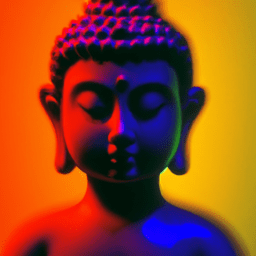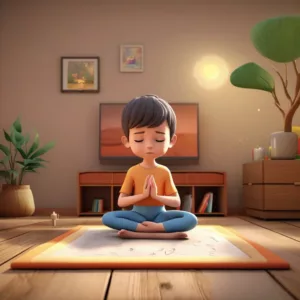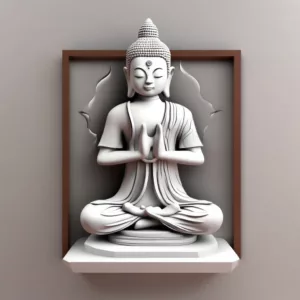To meditate correctly, you must first understand what meditation means. Meditation is sustained focus on an object. The 9 ways of meditation will take you from beginner to expert in as little as 6 months of very strong practice.
| 3 Areas | 6 Powers | 9 Stages | 5 Obstacles | 8 Antidotes | 3 Qualities | Experience |
|---|---|---|---|---|---|---|
| Hearing/ contemplating | 1: Placecement | Laziness Forgetting the instructions | Faith Aspiration Exertion Shinjang | Stability | Movement/ Waterfall |
|
| Preparation | 2: Continuous placement | |||||
| 3: Repeated Placement | Elation & Dullness | |||||
| Actual Meditation | Mindfulness Introspection/ Awareness | 4: Close Placement | Introspection / Awareness | Clarity | Attainment / Brook | |
| 5: Taming | Familiarity Slow River |
|||||
| 6: Pacifying | Power / Strength | |||||
| Exertion | 7: Thoroughly pacifying | Not applying antidotes | Applying antidotes | Stability / Calm Lake | ||
| Increasing Meditation | 8: One-pointedness | Overapplying antidotes | Resting in Equanimity | |||
| Thorough Familiarity | 9: Equanimity | Perfection/Mountain |
Table of Contents
Secrets of Meditation for Anxiety
Like millions of people, you may have suffered from anxiety for years. Meditation, yoga, peaceful music – it never works. It takes too long, and it’s not stable. Why? Because peace is treated as a cause for freedom, but it’s not – it’s the result. The cause to free yourself from anxiety is completely different.
Click now to Overcome Anxiety for good.
First Stage of Meditation: Placement

Different stages of meditation always begin with the first key instruction: placing the mind. The first stage of meditation is about overcoming the tendency to be scattered: not quite meditating, and not making an effort to meditate. That is laziness technically.
PDF Download
First Obstacle to Meditation – Laziness
Laziness, therefore, is the first obstacle to meditation. It’s what prevents meditation from occurring in three ways. The other obstacles occur during meditation and they prevent strong clarity of the object and they prevent power from developing. But the first obstacle is laziness.
Most people think the point of meditation is peace and so forth. At some level this is true, but the more immediate point is to understand the object that the mind is focused on.
At a certain level, there is conceptual learning, but mindfulness is direct learning. It is
experiencing the object directly without any interference.
Therefore, the mind learns about it. With profound objects, this is necessary. No conceptual learning can take you to the depth of the essence. No conceptual learning about the breath can give you the experience of feeling, and breathing. There is no conceptual speech about red that can teach color to a blind man. It must be seen to be believed.
How to meditate like a yogi
and enter profound samadhi
The ten stages of meditation
The 10 stages of meditation are actually the 9 stages of resting the mind plus the beginning of preparation. The preparation was covered in Part I: How to Meditate Properly. This post covers the first section of the 9 stages, especially the Placements. This is learning to truly meditate.
Preparation means facing the first obstacle: laziness. There are four antidotes to laziness:
- Faith
- Aspiration
- Exertion
- Shinjang
Faith means believing that this can work and provide benefit. It can also mean that you have faith or trust in the advice of wisdom beings in the past who say that meditation is very helpful.
Aspiration is specifically setting a goal to accomplish something. As in, I will meditate correctly and fully within one month. I will understand it. I will use it to overcome my anxiety, for example.
Exertion is making the effort on a daily basis. Getting to your cushion and also very important, applying the instructions. More on this in a bit.
Shinjang means thoroughly processed. It means that you have trained your mind to meditate through thick and thin. If it’s easy, great. If it’s hard, fine. Just do it.
How to Meditate Correctly, Part 2: Placement of Mind
Placement is the first stage of meditation. In the beginning at first with placement there’s a sense of something really happening but soon enough the mind will wander. This is inevitable and should not be regarded as problem particularly. It is an obstacle and it
should be worked with and eventually overcome but at this point we just need to make the commitment to working with meditation.
In other words, bring the mind back to the object of meditation. With a strong motivation
and strong application of effort, it does not take that long to move through the stage of
placement. Three or four days of daily practice of twenty minutes suffices.
We’re trying to develop a little stability on the breath. Remember this may feel frustrating, but make a commitment to stick with it for a specific period of time. Give meditation 6 months or so before deciding. The commitment helps a lot.
The second stage is continuous placement. The mind tends to wander quite a bit still. In the second, the next obstacle comes up. We’ve gotten through the laziness – we’re going to meditate. We’re on our cushion.



The next obstacle is forgetting the instructions. We just don’t know why we’re there or what we’re doing. It seems like it’s easy and clear when you’re reading it always makes sense. Put the mind on the object of meditation – the breathing. Apply the antidotes.
But then when we sit down and the mind just goes blank. We don’t know what we’re doing.
If the instructions are vague or there’s a lack of clarity in what we’re doing in the meditation, we’re forgetting the instructions on meditation.
This problem returns again and again and again as we go through the stages and even as we go through more and more profound meditations. In fact, it can be much more of a problem at the highest levels of meditation because the object of meditation is so subtle and refined that it’s almost impossible to find the object in itself.
So, remember the instructions. Go over them again and again. Get a bullet point list of them and read through them just before meditating. Have the instructions at your meditation cushion. Pick them up before you begin to meditate and simply read through them. Memorize a certain level of instructions so now they’re supporting you. Just memorize the concise instructions for meditation.
How to Meditate Correctly pdf – key instructions
As you move throught the 9 stages, three experiences occur:
- Movement / Waterfall – Stage 1
- Attainment / Brook – Stage 4
- Familiarity Slow River- Stage 5
- Stability / Calm Lake – Stage 7
- Perfection Mountain – Stage 9
a very important experience happens at this stage. It’s called the ‘waterfall.’ The thoughts come like a torrent. They’re out of control. They’re just unbelievable.
However, it’s not that we have more thoughts. It’s just that finally we’re paying some attention to the mind in a direct way. We’re tuning that awareness into the mind itself and what it’s doing. The thoughts can seem overwhelming as if we can never cut through them to actually meditate on the object.
It’s critical to relate to this experience as it is accept it and to realize that this is part of the journey and it is a difficult one getting seduced by our thoughts because that’s what mind does. At this stage we’re engaging meditation through focus or concentration of the mind. It’s an effortful process, so bringing the mind back to the object is important.
It’s probably better at the first and even in second the stage to have many more short sessions. Ten minutes, fifteen minutes or so, even five minutes and then to keep doing it whenever you get the chance to. Have two or three formal sessions a day where you sit down and focus the mind on the breathing. Time it for five to ten minutes and then get up and clear the mind.

Flow, the profound mental state, also called Peak Performance, can be attained with meditation and can be ‘triggered’ at will, with enough discipline. Guide to Flow Mastery will teach you how.
If you feel inspired have a longer session like an hour. Meditate for five to ten minutes, get up, take a break for a few minutes and come back. You’re still in the meditation you’re just doing part of the meditation which is releasing the intensity and coming back and focusing and concentrating again and then releasing and focusing again. Going back and forth like that. Otherwise it becomes too difficult. The mind rebels because it has not been trained to maintain steady concentration.
Stable long-lasting concentration comes later. At this point we’re just training the mind in what concentration is, how to deal with thoughts, how to maintain focus, how to maintain posture, and so forth. Engage in it with strong effort and then release the effort to refresh and back and forth like that. That is the advice classically.
Twenty one breaths is a normal approach at first. If your mind stays with the meditation for twenty one breaths and that happens every day consistently, then that is considered to be accomplishing the first stage of placement.
Stage 2 Continuous Placement and 3 Repeated Placement
In Continuous placement the mind extends itself to approximately a hundred and eight breaths. Meditation begins to become enjoyable at this stage.
In the third stage of repeated placement we generally have stable concentration but the mind will be leaving off on its own thing periodically. Repeated placement means we repeatedly have to go and pull it back in.
Looking at this you can see how important it is to understand what we’re doing when we meditate.
Maintain the mind’s focus on the object
This quote is the definition of meditation and having that basic definition all the other pieces begin to fall into place around that idea. In the next section we’ll look at Stage 4 – Close Placement, where the mind no longer wanders from the object.
This is where true meditation begins.
Part I: How to Meditate Properly
Part III
faq
How do I know if I’m meditating correctly?
You know if you’re meditating correctly when you have studied the meaning and principles of meditation. In essence, if the posture is good and the mind focuses on the chosen object, you are meditating correctly.
Are you thinking when meditating?
You are thinking while you meditate because you can’t really stop thoughts. The skilled meditator sees through them and does not follow thoughts. This slows thoughts dramatically.
What is the first rule in meditation?
The first rule in meditation is knowing what meditation is so that you actually engage in it. Maintaining the mind’s focus on the object IS meditation.
How do I stop thinking when meditating?
You don’t stop thinking when meditating because it’s not possible. You release thoughts by knowing they are only thoughts with no power over you. Then return to the meditation. Thoughts will decrease naturally but not truly cease.
Why can’t I clear my mind when meditating?
You can’t clear your mind when meditating if you try to clear your mind. Instead focus diligently, unwaveringly but gently on the object of meditation. The mind, being totally engaged in the meditation, will clarify itself naturally.
How many minutes should a beginner start with when meditating?
A beginner should start with 10 minute sessions for meditation. Make it easy and enjoyable. It’s better to do more brief sessions at first than one long one.

May all beings be happy
May all beings be peaceful
May all beings be safe
May all beings awaken to the light of their true nature
May all beings be free







